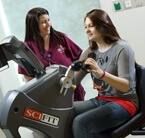
Physical therapist Christy McKinney helps patient Catherine Lilly build her endurance in Johns Hopkins’ new dedicated pediatric physical rehabilitation suite.
Indeed, Internet searches suggested a difficult-to-diagnose condition called postural orthostatic tachycardia syndrome, or POTS, and its hallmark symptom—recurring tachycardia as the patient stands up. As the peripheral blood vessels fail to constrict in order to send more blood to the upper body, explains Johns Hopkins pediatrician Peter Rowe, the heart attempts to compensate by pumping faster. With comorbid conditions including allergies, anxiety, depression, fatigue and headaches, Rowe notes, POTS can be challenging to treat.
“Our understanding of POTS and its range of related illnesses is incomplete and management strategies are primarily symptomatic and partially successful,” says Rowe.
Current treatment recommendations include medications like beta blockers to attenuate tachycardia and vasoconstrictors to reduce pooling of blood in the lower extremities, as well as wearing compression garments, increasing electrolyte and water intake, and avoiding excessive bed rest and prolonged sleeping. Exercise has been reported to help in alleviating POTS symptoms, too, and can play a role in improving daily function (J Am Coll Cardio. June 22, 2010; 55(25):2858-2868). Such findings have led Johns Hopkins Children’s Center to develop a formal, multidisciplinary physical therapy program for pediatric patients with POTS to build up their endurance and tolerance to be upright and, in so doing, engage in daily activities. For POTS patients, says pediatric physical therapist Christy McKinney, that’s not so easy.
“A lot of times these kids are limited in doing even the simplest tasks, like walking or taking a shower, because they get too fatigued,” says McKinney. “Building their endurance allows them to do as much as they can at home or at school.”
In the 12-to-16 week program, patients first undergo a modified shuttle walk test, with monitoring of heart rate and oxygen consumption, for a baseline assessment of their endurance. Then, in twice weekly sessions, patients begin stretching and strengthening exercises, followed up by aerobic exercise on a recumbent bicycle. While McKinney focuses on physical therapy, pediatric occupational therapist Jennifer Severt works with patients on behavior modification and scheduling strategies. Child psychologist Laura Goldstein then helps families support the schedule.
Patients keep a log of their activities—data that McKinney hopes will enrich the limited research on the benefits of physical therapy. How are patients doing?
“As far as their ability to complete activities at home and school, we’re seeing progress,” says McKinney.
“Catherine still has her ups and downs,” adds Kristina Lilly, “but the numbers show improvement.”
##
